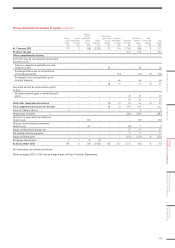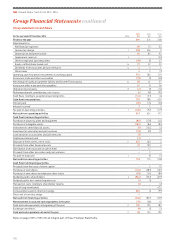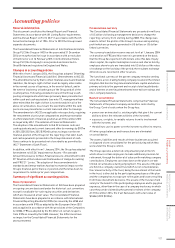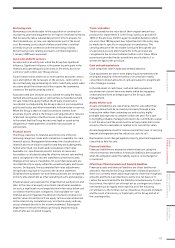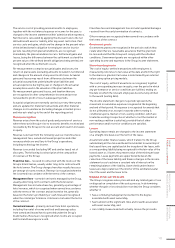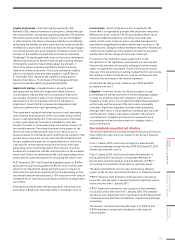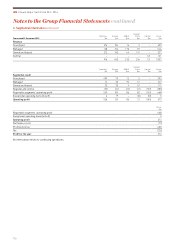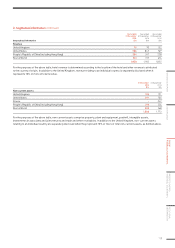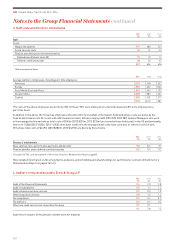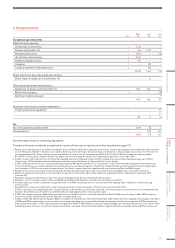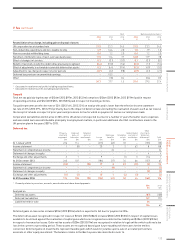Holiday Inn 2014 Annual Report Download - page 115
Download and view the complete annual report
Please find page 115 of the 2014 Holiday Inn annual report below. You can navigate through the pages in the report by either clicking on the pages listed below, or by using the keyword search tool below to find specific information within the annual report.
Loyalty programme – the hotel loyalty programme, IHG
Rewards Club, enables members to earn points, funded through
hotel assessments, during each qualifying stay at an IHG branded
hotel and redeem points at a later date for free accommodation
or other benefits. The future redemption liability is calculated by
multiplying the number of points expected to be redeemed by the
redemption cost per point. On an annual basis the Group engages
an external actuary who uses statistical formulas to assist in the
estimate of the number of points that will never be redeemed
(‘breakage’). Actuarial gains and losses on the future redemption
liability are borne by the System Fund and any resulting changes
in the liability would correspondingly adjust the amount of
short-term timing surpluses and deficits held in the Group
statement of financial position. The future redemption liability,
which is included in trade and other payables, was $725m at
31 December 2014. Based on the conditions existing at the
balance sheet date, a 1% decrease in the breakage estimate
would increase this liability by approximately $7m.
Impairment testing – intangible assets, property, plant
and equipment are tested for impairment when events or
circumstances indicate that their carrying value may not be
recoverable. Goodwill is subject to an impairment test on an
annual basis or more frequently if there are indicators of
impairment. Assets that do not generate independent cash
flows are combined into cash-generating units.
The impairment testing of individual assets or cash-generating
units requires an assessment of the recoverable amount of the
asset or cash-generating unit. If the carrying value of the asset
or cash-generating unit exceeds its estimated recoverable
amount, the asset or cash-generating unit is written down to its
recoverable amount. Recoverable amount is the greater of fair
value less costs of disposal and value in use. Value in use is
assessed based on estimated future cash flows discounted to their
present value using a pre-tax discount rate that is based on the
Group’s weighted average cost of capital adjusted to reflect the
risks specific to the business model and territory of the cash-
generating unit or asset being tested. The outcome of such an
assessment is subjective, and the result sensitive to the assumed
future cash flows to be generated by the cash-generating units or
assets and discount rates applied in calculating the value in use.
At 31 December 2014, the Group had intangible assets of $569m
and property, plant and equipment of $741m, none of which were
subject to an impairment charge during the year. In respect of
those assets requiring an impairment test and depending on how
recoverable amount was assessed, a 10% reduction in fair value or
estimated future cash flows would have resulted in an impairment
loss of $7m.
Information on impairment testing of goodwill, which had a net
book value of $74m at 31 December 2014, is included in note 12.
Income taxes – deferred tax assets are recognised to the
extent that it is regarded as probable that deductible temporary
differences can be realised. The Group estimates deferred tax
assets and liabilities based on current tax laws and rates,
and in certain cases, business plans, including management’s
expectations regarding the manner and timing of recovery of the
related assets. Changes in these estimates may affect the amount
of deferred tax liabilities or the valuation of deferred tax assets
and therefore the tax charge in the income statement.
Provisions for tax liabilities require judgements on the
interpretation of tax legislation, developments in case law and
the potential outcomes of tax audits and appeals which may be
subject to significant uncertainty. Therefore the actual results
may vary from expectations resulting in adjustments to provisions,
the valuation of deferred tax assets, cash tax settlements, and
therefore the tax charge in the income statement.
Exceptional tax charges and credits arose in 2013 and 2012
as explained in note 7.
Litigation – from time to time, the Group is subject to legal
proceedings the ultimate outcome of each being always subject
to many uncertainties inherent in litigation. A provision for
litigation is made when it is considered probable that a payment
will be made and the amount of the loss can be reasonably
estimated. Significant judgement is made when evaluating,
amongst other factors, the probability of unfavourable outcome
and the ability to make a reasonable estimate of the amount
of potential loss. Litigation provisions are reviewed at each
accounting period and revisions made for changes in facts
and circumstances.
New standards issued but not effective
The new and amended accounting standards discussed below are
those which are expected to be relevant to the Group’s financial
statements.
From 1 January 2015, the Group will apply the amendments
to existing standards arising from the 2010-2012 and 2011-2013
annual improvements cycles.
From 1 January 2016, the Group will apply Amendments to
IAS 16 and IAS 38 ‘Clarification of Acceptable Methods of
Depreciation and Amortisation’ and Amendments to IFRS 11
‘Accounting for Acquisition of Interests in Joint Operations’.
The above amendments are not expected to have a material
impact on the Group’s reported performance or financial position.
IFRS 15 ‘Revenue from Contracts with Customers’ introduces
a new five-step approach to measuring and recognising revenue
and is effective from 1 January 2017.
IFRS 9 ‘Financial Instruments’ was issued as a final standard
in July 2014 and is effective from 1 January 2018. The standard
introduces new requirements for classification and measurement
of financial assets and financial liabilities, impairment and hedge
accounting.
The Group is currently assessing the impacts of IFRS 15 and
IFRS 9 and plans to adopt both standards on the required
effective dates.
STRATEGIC REPORT GOVERNANCE
GROUP
FINANCIAL STATEMENTS
PARENT COMPANY
FINANCIAL STATEMENTS
ADDITIONAL
INFORMATION
113


